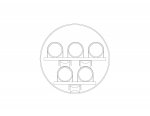smoothops10
Member
- Location
- FL
- Occupation
- EE
Like to get thoughts on running multiple conduits in a new ductile iron pipe installed with directional drill or jack and bore method.
Is it acceptable to install the pipe to get under a barrier that prohibits trenching, install the multiple sets of conduit in the pipe, and put a manhole on each side of the pipe (1600A, 480VAC, 4W). Manhole would have concrete encased ductbank exiting to a building on each side. Would probably use PVC 40 conduit in the pipe installed in 10' sections. Don't see how any conduit supports could be installed in the pipe so they'll be sitting on top of each other in the pipe. Thoughts?
Is it acceptable to install the pipe to get under a barrier that prohibits trenching, install the multiple sets of conduit in the pipe, and put a manhole on each side of the pipe (1600A, 480VAC, 4W). Manhole would have concrete encased ductbank exiting to a building on each side. Would probably use PVC 40 conduit in the pipe installed in 10' sections. Don't see how any conduit supports could be installed in the pipe so they'll be sitting on top of each other in the pipe. Thoughts?
Last edited:

